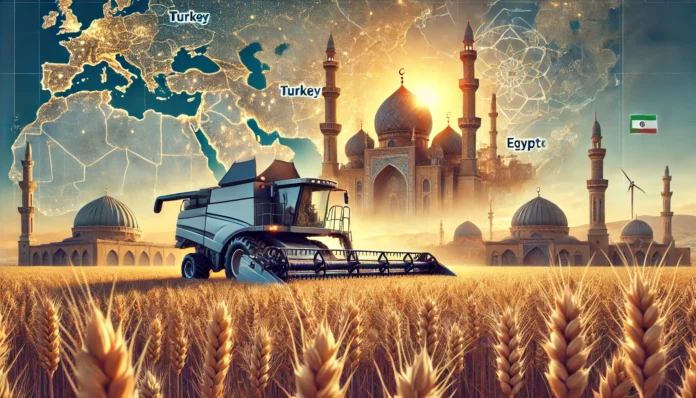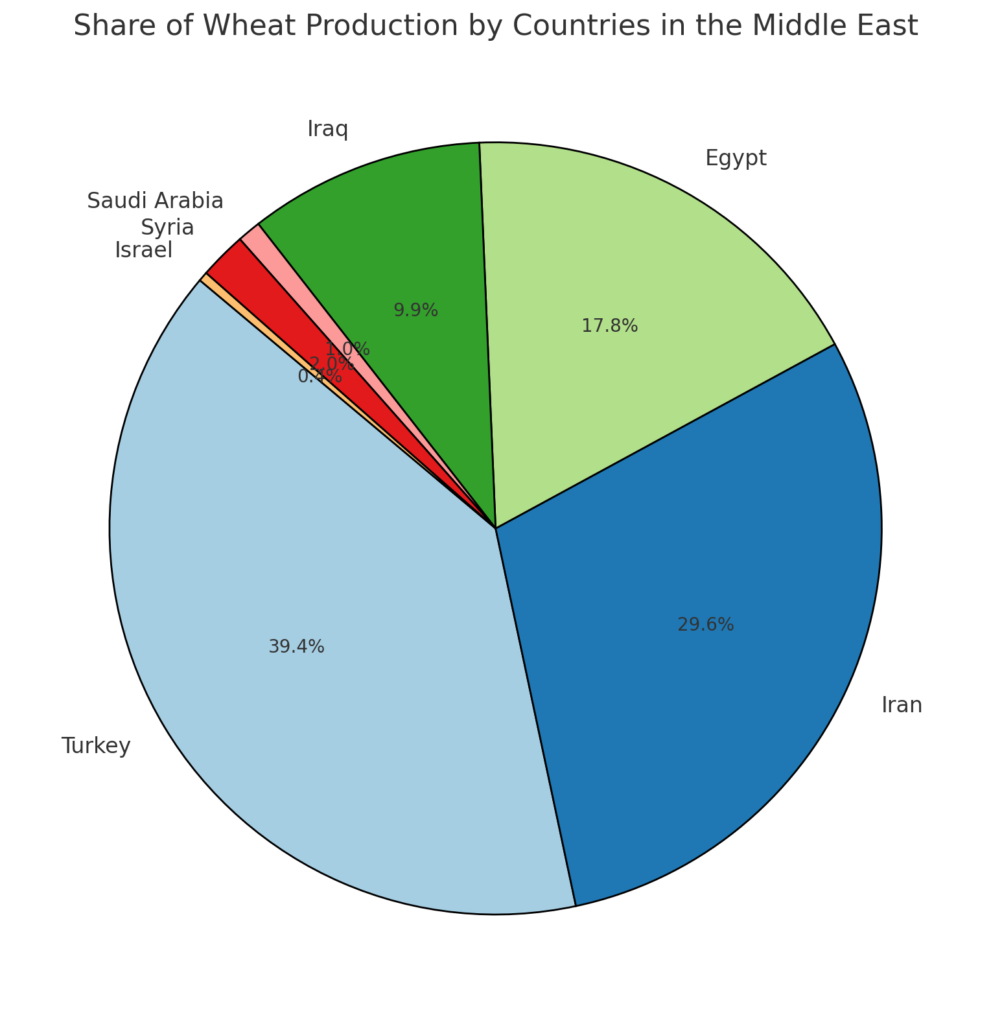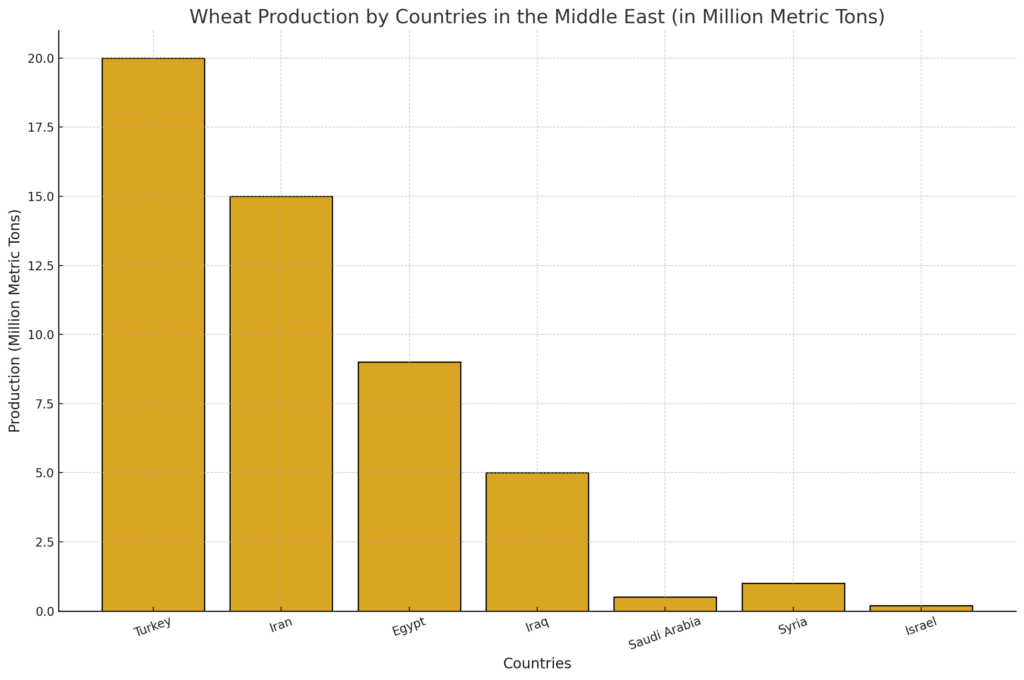
The Middle East, home to the Fertile Crescent, has a rich history of wheat cultivation. While the region faces significant challenges such as water scarcity and climate change, several countries continue to contribute substantially to wheat production. This report highlights the leading wheat producers in the Middle East, their strategies, and the obstacles they face in maintaining agricultural output.

1. Turkey: The Leading Wheat Producer
Turkey is the largest wheat producer in the Middle East, benefiting from its diverse climate and extensive arable land.
Key Highlights:
- Annual Production: Approximately 20 million metric tons.
- Major Regions: Central Anatolia, Thrace, and Southeastern Turkey.
- Specialty: Produces high-quality hard wheat for bread and pasta.
- Challenges: Climate variability and rising water demands impact production.
Turkey’s wheat industry supports both domestic consumption and exports to neighboring countries.
2. Iran: A Significant Contributor
Iran has a well-established wheat sector, supported by government policies aimed at achieving self-sufficiency.
Key Highlights:
- Annual Production: Around 13-15 million metric tons.
- Key Regions: Khorasan, Khuzestan, and Fars provinces.
- Government Support: Subsidies and guaranteed purchase prices encourage production.
- Challenges: Sanctions and water scarcity hinder agricultural development.
Iran’s wheat production is vital to its food security, though the country remains partially dependent on imports.
3. Egypt: Balancing Production and Imports
While Egypt is part of the Middle East and North Africa (MENA) region, it is a leading wheat producer and the world’s largest importer.
Key Highlights:
- Annual Production: Over 9 million metric tons.
- Cultivation Areas: Nile Delta and Upper Egypt.
- Reliance on Imports: Domestic production meets only about half of the country’s demand.
- Challenges: Limited arable land and reliance on irrigation systems.
Egypt’s wheat industry is heavily supported by government programs to ensure food security.
4. Iraq: Rebuilding Agriculture
Iraq is rebuilding its wheat industry after years of conflict and instability.
Key Highlights:
- Annual Production: Around 3-5 million metric tons.
- Key Regions: Tigris-Euphrates basin.
- Focus: Rehabilitating irrigation infrastructure and supporting smallholder farmers.
- Challenges: Political instability and insufficient resources for modern agriculture.
Iraq’s wheat sector is a vital component of its recovery and economic stability.
5. Saudi Arabia: Scaling Back for Sustainability
Saudi Arabia previously aimed for wheat self-sufficiency but scaled back production to conserve water.
Key Highlights:
- Controlled Production: Focuses on strategic wheat reserves.
- Water Conservation: Phased out large-scale cultivation in the 2010s.
- Imports: Relies on global markets to meet domestic demand.
Saudi Arabia’s wheat strategy prioritizes sustainability while ensuring food security through imports.
6. Syria: A Traditional Producer Facing Challenges
Syria was once a major wheat producer in the region but has faced severe disruptions due to ongoing conflict.
Key Highlights:
- Pre-Conflict Production: Approximately 4 million metric tons annually.
- Key Regions: Al-Hasakah and Euphrates basin.
- Current Situation: Production has declined sharply due to war and displacement.
Efforts to revive Syria’s wheat industry are critical for its recovery and food security.
7. Israel: Focused on Innovation
Israel has a modest wheat industry, leveraging advanced technology to maximize production.
Key Highlights:
- Production Volume: Limited but efficient.
- Regions: Negev Desert and surrounding areas.
- Innovation: Advanced irrigation techniques and research on drought-resistant crops.
- Reliance: Imports most of its wheat to supplement local production.
Israel’s focus on technology ensures its wheat production remains efficient and sustainable.

Challenges in Middle Eastern Wheat Production
- Water Scarcity: Limited freshwater resources hinder irrigation-dependent farming.
- Climate Change: Rising temperatures and erratic rainfall affect yields.
- Geopolitical Issues: Conflict and instability disrupt agricultural activities and trade.
- Infrastructure Deficiencies: Poor storage and transport facilities lead to post-harvest losses.
Opportunities for Growth
- Irrigation Modernization: Expanding efficient irrigation systems can boost yields.
- Technology Integration: Adoption of precision farming and drought-resistant wheat varieties.
- Regional Cooperation: Collaborative efforts to stabilize trade and share resources.
- Public-Private Partnerships: Investments in modern farming practices and infrastructure.
Conclusion
Wheat production in the Middle East is shaped by a combination of historical significance, modern challenges, and opportunities for innovation. Countries like Turkey, Iran, and Egypt lead the region, while others like Iraq and Syria strive to rebuild their agricultural sectors. By addressing climate and water challenges, the Middle East can enhance its wheat production and ensure regional food security.



